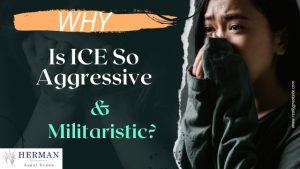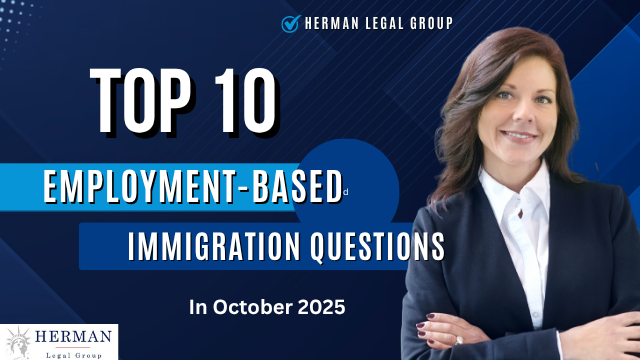By Richard T. Herman, Esq.
*Immigration Lawyer for Over 30 Years | Founder of the Herman Legal Group | Co-Author of Immigrant, Inc.

Introduction: The Rise of ICE’s Aggressive Tactics
Across major U.S. cities — Chicago, Los Angeles, New York, and Washington, D.C. — federal immigration enforcement has entered a new phase defined by visible militarization. Blackhawk helicopters thunder over neighborhoods; agents in tactical gear and face masks sweep courthouses and factories; armored vehicles idle outside apartment blocks during pre-dawn raids.
This posture marks a dramatic shift from ICE’s original “worst-first” philosophy, which focused on individuals with serious criminal records. Today’s operations often target anyone lacking lawful status, regardless of family or community ties. Former acting ICE Director John Sandweg calls the current approach “unprecedented in scope and intensity.”
ICE’s aggression in 2025 stems from political mandates prioritizing volume over safety, expanded authority under executive orders, and an organizational shift toward militarized urban operations.
What Does “Aggressive” Mean in ICE’s Context?
In law-enforcement terms, “aggressive” reflects three dimensions:
- Tactical aggression — use of SWAT-style equipment, long guns, and riot control methods.
- Operational aggression — mass sweeps and broad arrest quotas.
- Legal aggression — stretching detention authority and reducing discretion for low-risk noncitizens.
According to the Department of Homeland Security, ICE’s Enforcement and Removal Operations (ERO) division now coordinates with the FBI and Border Patrol in joint urban deployments, effectively merging immigration enforcement with counter-crime and counter-terrorism tactics.
How Has ICE’s Mission Changed Since Its Founding?
ICE was created in 2003 after 9/11 to unify immigration and customs functions under DHS. Initially it focused on targeted arrests of criminal aliens and smuggling networks. From 2009–2016, the agency followed the “Priority Enforcement Program,” emphasizing public-safety threats and recent border crossers.
By contrast, since 2024, executive orders and DHS policy memoranda have erased most categorical limits. Now, undocumented status alone is grounds for arrest, a change confirmed by ICE’s FY 2025 report.

When Did the Shift Toward Militarization Begin?
The seeds of ICE’s militarization were planted after 9/11, when DHS adopted a national-security framework for all enforcement branches. However, the full military-style transformation accelerated in 2025 under renewed political directives.
A Migration Policy Institute analysis notes that ICE now deploys more tactical teams and helicopter support than at any point since its creation. Urban areas see simultaneous multi-site raids involving hundreds of officers. Local officials describe these as “shock operations” reminiscent of military counterinsurgency.
ICE’s militarization began as a counterterrorism holdover and expanded in 2025 through federal directives favoring visible force and mass deterrence.
What Are ICE’s Main Enforcement Tactics in 2025?
- Large-Scale Urban Sweeps — coordinated operations in residential complexes and industrial zones.
- Joint Task Forces with the FBI and local police.
- Aerial Support using Blackhawk and Lakota helicopters for surveillance and intimidation.
- Facial Concealment and Armored Vehicles for crowd control.
- Data-Driven Targeting based on ICE and CBP databases cross-matched with state records.
According to ICE’s ERO Statistics Dashboard, arrests in the first half of FY 2025 rose 38 percent year-over-year. About 47 percent of those detained had no criminal record.
Why Are ICE Agents Wearing Masks and Carrying Military-Grade Gear?
ICE agents cite security concerns and online doxxing as reasons for wearing balaclavas and face shields. However, critics argue that concealing identity reduces accountability. No federal law requires masking, but DHS policy permits it for officer safety.
Masks and military-grade gear serve both protection and deterrence functions, but they also symbolize the blur between civil enforcement and paramilitary operation.
As former Director Sandweg told Politico, “I hate that the agents are wearing masks … it’s hurting the agency’s reputation.”
What Political Forces Are Driving ICE’s Expansion?
Immigration enforcement has become a central pillar of national politics. Presidential executive orders issued in early 2025 designated immigration as a “whole-of-government priority,” authorizing inter-agency personnel sharing and expedited funding for ICE recruitment.
The Department of Justice and the Department of Defense have also been tasked with support roles in intelligence and training. Political rhetoric frames ICE as a symbol of sovereignty and border control, leading to budget expansion and public pressure for visible results.
How Do Federal and Local Law Enforcement Overlap?
Through 287(g) agreements, local police can act as ICE extensions, accessing federal databases and initiating immigration holds. Cities like Los Angeles and Chicago officially limit cooperation, but task forces often circumvent those restrictions via joint operations.
The American Immigration Council has documented civil rights violations arising from these arrangements, including racial profiling and wrongful detentions.
ICE’s collaboration with local law enforcement blurs jurisdiction lines, spreading federal immigration authority deep into community policing.
Are ICE’s Tactics Legal Under U.S. Law?
ICE derives arrest authority from the Immigration and Nationality Act (INA §287). However, the Constitution requires that such actions respect Fourth Amendment protections against unreasonable searches and seizures.
Civil-rights organizations like the ACLU argue that no-warrant home raids, use of force without threat, and racial profiling constitute systemic violations. Federal courts have begun issuing injunctions limiting ICE operations around schools and religious sites.
How Do These Operations Affect Immigrant Communities?
Aggressive enforcement creates a climate of fear that extends far beyond those directly targeted. Families avoid hospitals and schools; crime reporting drops; and mixed-status households face constant anxiety. Sociologists at UCLA found that Latino neighborhoods in Los Angeles experienced a 30 percent decline in civic engagement after raids.
ICE’s aggressive tactics erode trust, reduce public safety cooperation, and inflict psychological harm on U.S. citizen families within immigrant communities.
What Are the Economic and Social Consequences?
Economists at Brookings Institution and the National Bureau of Economic Research link mass workplace raids to billions in lost GDP and supply-chain disruptions. A case study in Oxnard, California, found a 20–40 percent labor shortage and $3–7 billion in agricultural losses after ICE operations in 2025.
Socially, detention and family separation strain local social services and increase child poverty rates. The Urban Institute reports that each ICE raid in a metro area correlates with a 10 percent uptick in school absenteeism among immigrant children.
Are ICE Agents Themselves at Risk?
Behind every enforcement image are officers operating under extraordinary pressure.
Assaults on immigration agents have increased by more than 500 percent since 2023, according to the Department of Homeland Security.
Agents have become targets for protesters and online “doxxing” campaigns.
Former ICE leadership notes that morale is deteriorating as agents confront hostility from both the public and policymakers. “They’re carrying out national policy, not making it,” says Sandweg.
Rising public anger and unsafe field conditions push ICE officers toward heavier gear, mask-wearing, and defensive aggression—creating a cycle that further militarizes enforcement.
Can Oversight or Reform Reduce the Aggression?
Experts emphasize that congressional and judicial oversight can moderate ICE’s reach, but political polarization has eroded those guardrails.
Oversight mechanisms currently in place include:
- DHS Office of Inspector General (OIG): Investigates misconduct and detention conditions.
- Civil Rights and Civil Liberties Office (CRCL): Handles discrimination complaints.
- Judicial Review: Federal courts occasionally issue injunctions restraining operations.
However, the OIG has only limited investigative bandwidth, and congressional hearings have become partisan showdowns rather than accountability sessions.
Policy scholars at the Migration Policy Institute recommend creating an independent immigration-enforcement oversight board, similar to police-review commissions, with authority to audit use-of-force incidents and transparency metrics.
True reform requires independent oversight, congressional guardrails, and transparency metrics that track ICE raids, arrests, and use of force.
Case Studies: Chicago, Los Angeles, New York, and Washington D.C.
Chicago: “Operation South Side”
In summer 2025, ICE and Border Patrol launched a joint operation detaining more than 300 people in a single South Side apartment complex. Local clergy and journalists alleged excessive force—pepper-ball rounds, drones, and flash-bangs.
A federal judge later barred federal agents from threatening or detaining journalists, citing First Amendment violations. (Chicago Tribune)
Los Angeles: Industrial-Zone Raids
L.A.’s garment and food-processing districts saw mass detentions of day laborers.
Footage analyzed by the Los Angeles Times confirmed masked agents in military armor carrying M4-style rifles. UCLA researchers reported that nearby immigrant neighborhoods experienced a 25 percent drop in retail spending immediately afterward.
New York City: Courthouse Confrontations
Outside 26 Federal Plaza, officers were filmed shoving a woman to the ground; the agent was removed from duty. Civil-liberties groups such as the ACLU of New York are pressing for “ICE-free zones” near state courthouses.
Washington D.C.: Helicopter Hover and Federal Symbolism
During protests outside DHS headquarters, observers recorded Blackhawk helicopters hovering at low altitude—a tactic reminiscent of 2020 civil-disturbance responses.
Legal analysts at Georgetown Law argue these optics fuse military power with domestic enforcement, undermining public trust.
Major U.S. cities now witness ICE operations that resemble tactical occupations—mask-clad teams, aerial support, and mass detentions once unthinkable in civil enforcement.
International Comparison: How U.S. ICE Differs from Other Countries’ Agencies
Other nations manage immigration enforcement under administrative ministries rather than national-security umbrellas.
| Country | Agency | Approach | Distinguishing Features |
| Canada | CBSA | Civil administrative focus | Emphasizes voluntary compliance, not paramilitary raids |
| U.K. | Home Office Immigration Enforcement | Police collaboration but limited weaponization | Officers rarely carry firearms |
| Australia | ABF | Border protection with regional detention | Uses civilian contractors for removals |
| United States | ICE (DHS) | National-security framing | Tactical teams, firearms, cross-agency operations |
As policy researchers at Oxford Migration Studies note, “The U.S. is unique in fusing immigration control with paramilitary policing.”
Unlike peer democracies, the U.S. frames immigration enforcement as national security, institutionalizing militarized tactics within ICE.
Expert Analysis: Perspectives from Former ICE Chiefs and Scholars
John Sandweg, former ICE director, explains:
“Historically, ICE went after the ‘worst first.’ That’s gone. The agency is now rewarded for volume, not precision.” (Politico Magazine, Oct 2025)
Theresa Cardinal Brown of the Bipartisan Policy Center adds that DHS metrics focus on “total apprehensions” rather than criminal severity, incentivizing broad sweeps.
Academics at the University of California San Diego argue that this metric-driven model “creates political theater without improving public safety.”
Experts agree ICE’s aggression is driven by performance metrics—numbers of arrests and deportations—rather than evidence of greater public-safety threats.
Policy Path Forward: What Would Real Reform Look Like?
- Re-Establish Enforcement Priorities
Restore “worst-first” directives focusing on violent offenders and national-security threats. - Independent Oversight Board
Modeled on police-review commissions, with subpoena power over DHS records. - Transparency Dashboards
Publicly report monthly arrest and use-of-force statistics. - Expand Alternatives to Detention (ATD)
DHS already supervises over 183,000 people through electronic monitoring (TRAC Reports); scaling ATD could cut detention costs and abuses. - Community Engagement Protocols
Fund local “trust programs” where ICE communicates with advocacy groups before large operations. - Legislative Reform
Congress should codify proportional-force standards and limit funding absent compliance benchmarks. - Officer Training and Mental-Health Support
Expanded ethics curricula and trauma-care resources could reduce over-reliance on force.
Lasting reform depends on narrowing ICE’s mission, enforcing transparency, and creating humane, evidence-based enforcement priorities.
Conclusion: The Cost of Unchecked Enforcement
Two decades after its creation, ICE now stands at a crossroads.
Once tasked with precision law enforcement, it increasingly mirrors a domestic military force—armored, masked, and politically weaponized.
Unchecked aggression carries steep costs:
- Erosion of civil liberties and community trust
- Billions in economic losses from workforce disruption
- Moral injury to agents and families alike
- Deepening polarization around immigration policy
As an immigration lawyer for more than 30 years, I’ve seen how enforcement pendulums swing between compassion and crackdown.
History shows that real security comes not from fear, but from fair and rational law.
America can enforce its borders without losing its soul.
Key Takeaways
- ICE’s aggression in 2025 reflects a shift from “worst-first” to mass enforcement driven by political mandate.
- Militarized tactics — masks, rifles, helicopters — blur the line between civil and combat operations.
- Nearly half of ICE arrestees now have no criminal record.
- Urban raids in Chicago, L.A., New York, and D.C. illustrate an unprecedented federal footprint.
- Economic losses from labor disruptions reach billions nationwide.
- Oversight bodies remain weak; independent accountability is essential.
- Restoring “worst-first” priorities and expanding ATD programs would reduce harm and cost.
- True security depends on lawful, proportionate, transparent enforcement—not fear.
Author Bio / Profile

Richard T. Herman, Esq. is a nationally recognized immigration lawyer and founder of the Herman Legal Group.
With over 30 years of experience representing immigrants, families, and businesses worldwide, he has been featured in the New York Times, USA Today, and The Guardian.
He is the co-author of the book Immigrant, Inc., which celebrates the economic and cultural contributions of immigrants to America.
Learn more at Herman Legal Group – The Law Firm for Immigrants, or connect with Richard directly through his official bio page.








